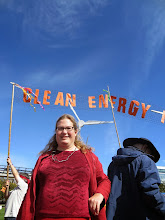Contact Governor Ritter at:
(303) 866-2471
136 State Capitol, Denver, CO 80203
-or-
http://www.colorado.gov/apps/oit/governor/citizen/assistanceUtility/shareOpinionGovOffice.jsf
Include "SoCo transmission line" in the subject.
The Accidental Solution to XCEL’s Solar Woes
A Colorado Startup Company Discovers Solar Farm Sites on Colorado’s Front Range
The Solar Panel Hosting Company, a Colorado start-up, has stumbled upon excellent solar farm sites in Jefferson County and elsewhere along the front range. Wholesale distributed solar development on these sites could meet XCEL Energy’s solar purchase requirements without requiring new transmission lines into the San Luis Valley.
XCEL energy recently announced that it would reduce its purchase of solar energy in Colorado if transmission line construction were delayed. Governor Ritter said he would try to negotiate with Trinchera Ranch to allow a transmission line to be built over La Veta Pass.
While looking for sites for projects under Colorado’s new Community Solar Gardens Act, we were approached by land owners with parcels from around 70 acres up to 320 acres who had been spurned by solar developers intent on very large sites in the San Luis Valley. The best of these sites is an old mine adjacent to a sub-station, zoned industrial, near existing transmission lines, and screened from view by a berm. The land owner is committed to developing his entire property for solar energy.
These sites could become wholesale distributed photovoltaic (PV) solar plants similar to the Solar One plant currently operating near the San Luis Valley town of Mosca. Solar One, covering approximately 100 acres, produces just over 8 Megawatts of power, the equivalent of 2500 typical home solar energy systems. This plant has generated almost no opposition, being fairly low to the ground, quiet, using very little water, and not requiring large mirrors. By contrast, the scenic San Luis Valley is facing proposals for concentrated solar thermal plants covering thousands of acres, involving mirrors and perhaps towers, noisy turbines or Stirling engines, and often requiring significant amounts of water.
Long transmission lines mean transmission losses. While good numbers are hard to come by, a former Governor’s Energy Office member (and transmission line supporter) suggested to me that transmission line losses between the San Luis Valley and the Front Range would be about 8-12%, with losses the greatest on hot days when demand is highest. On average, Alamosa receives about 15% more solar energy than Denver. This means the majority of the additional energy would be lost, turned into useless heat. The ratepayers pay for the transmission line and a markup to guarantee power company profits. Energy lost in transmission would still be counted as “renewable energy” under Colorado’s renewable portfolio standard.
The state’s current plan, the Renewable Energy Development Initiative (REDI) would involve putting nearly all of Colorado’s solar generation in the San Luis Valley. Opposition is strong- not just a billionaire or a few hippies, but ranchers, townspeople, and business owners as well. In our local Democratic caucus, we voted unanimously to consider the distributed alternatives before building new transmission lines.
Under Colorado’s new Renewable Portfolio Standard, by 2020 a minimum of 1.5% of our energy must come from wholesale distributed renewables, defined as less than 30 Megawatts. Remember, this is a minimum, not a maximum. In a conversation we had last March, our state Senator Gail Schwartz mentioned the idea of using 100 Solar One-sized plants to generate a Gigawatt of electricity. I suggested we spread these facilities all around sunny Colorado.
In California, PG&E recently announced a plan to build 500 Megawatts of distributed solar energy based around existing sub-stations. Another company has proposed five 10-Megawatt PV plants in New Mexico. Which company is this? XCEL energy!
If we tweak the plan and require XCEL to buy solar energy from wholesale distributed solar plants all around Colorado, we will spread around both the benefits and the impacts. I can’t imagine a county commissioner or state legislator that wouldn’t want the improvement in their tax and jobs base, while at the same time reclaiming damaged land.


No comments:
Post a Comment